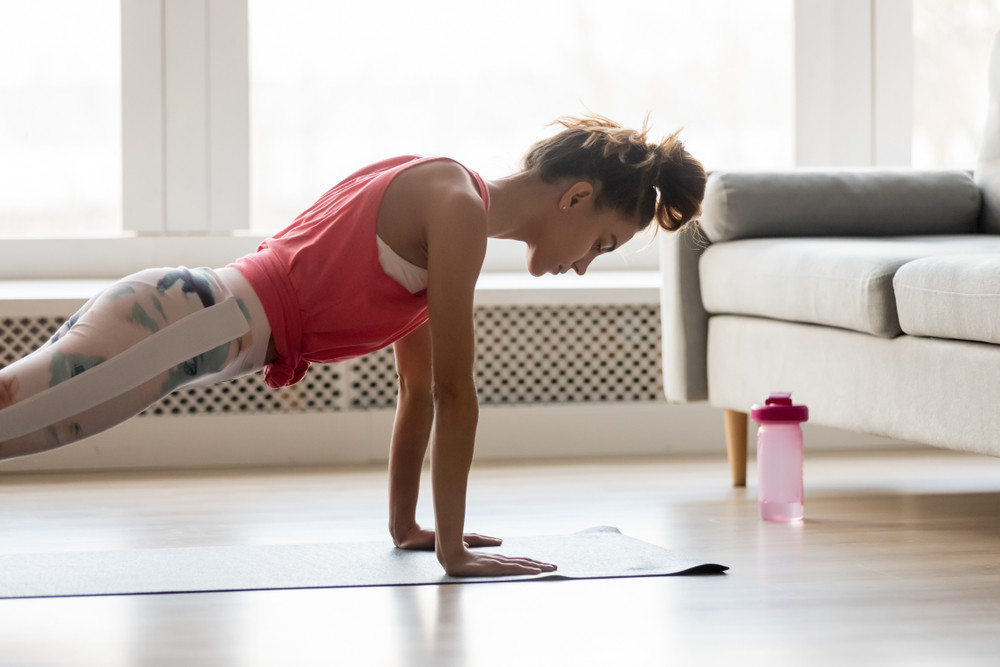Popular Reads
Top Results
Can't find what you're looking for?
View all search resultsPopular Reads
Top Results
Can't find what you're looking for?
View all search resultsShould I exercise during the coronavirus pandemic? Experts explain the just right exercise curve
Here’s how exercise affects the immune system in response to the flu and some practical tips on how much people should (and should not) exercise.
Change text size
Gift Premium Articles
to Anyone
S
o here we are, perfecting our social distancing skills while schools, sports and other forms of social engagement are on indefinite hold, by a dangerous virus named after a (regal) crown. The coronavirus is named because the center envelope is surrounded by small protein spikes called peplomers. These little protein spikes wreak havoc when they attach to lung tissue and hijack otherwise healthy tissue into building a potentially lethal coronavirus army of invaders.
Because the virus settles primarily with the respiratory tract – the nose, mouth and lungs – it is highly contagious when people sneeze, cough or exchange respiratory droplets with others. Despite its importance, social distancing has been a social disappointment for many weekend warriors, team sport athletes, fitness fanatics and sports fans who find camaraderie, biochemical joy from dopamine rushes or stress reduction through regular exercise and sport.
We are both sports scientists who study athlete health and safety. We’re also proud exercise addicts who find the prospect of not exercising almost as disturbing as the prospect of the disease itself.
Here’s how exercise affects the immune system in response to the flu and some practical tips on how much people should (and should not) exercise.
Look for the ‘just right’ amount
Both too much and too little are bad while somewhere in the middle is just right. Scientists commonly refer to this statistical phenomenon as a “J-shaped” curve. Research has shown exercise can influence the body’s immune system. Exercise immunity refers to both the systemic (whole body cellular response) and mucosal (mucous lining of the respiratory tract) response to an infectious agent, which follows this J-shaped curve.
A large study showed that mild to moderate exercise – performed about three times a week – reduced the risk of dying during the Hong Kong flu outbreak in 1998. The Hong Kong study was performed on 24,656 Chinese adults who died during this outbreak. This study showed that people who did no exercise at all or too much exercise – over five days of exercise per week – were at greatest risk of dying compared with people who exercised moderately.
Additionally, studies performed on mice demonstrated that regular exercise performed two to three months prior to an infection reduced illness severity and viral load in obese and non-obese mice.
Thus, limited animal and human data cautiously suggest that exercise up to three days per week, two to three months prior, better prepares the immune system to fight a viral infection.
What if we have not exercised regularly? Will restarting an exercise routine be good or bad? Limited data, also obtained from mice, suggests that moderate exercise for 20 to 30 minutes a day after being infected with the influenza virus improves the chances of surviving. In fact, 82% of the mice who exercised 20-30 minutes a day during the incubation period, or the time between getting infected with flu and showing symptoms, survived. In contrast, only 43% of the sedentary mice and 30% of the mice who performed strenuous exercise – or 2.5 hours of exercise a day – survived.
Therefore, at least in laboratory mice, mild to moderate exercise may also be protective after we get infected with the flu virus, whereas a little exercise is good while no exercise – or even too much exercise – is bad.
For those who are “committed exercisers,” how much exercise is probably too much during a flu pandemic? It is clear that both too much exercise and exercising while sick increases the risk of medical complications and dying.
We conducted studies on both collegiate football players and cross-country runners, which showed a decrease in secretory immunoglobulin A, or “sIgA” when athletes competed and trained hard. SIgA is an antibody protein used by the immune system to neutralize pathogens, including viruses.
SIgA is also closely associated with upper respiratory tract infections (URTI). When sIgA levels go down, URTI’s usually go up. We saw this relationship in football players, whereas the players showed the most URTI symptoms when their sIgA levels were lowest. This indirectly suggests that over-exercise without adequate recovery may make our body more vulnerable to attack, especially by respiratory viruses. So, when it comes to immunity, our studies show that more exercise is not necessarily better.
How much exercise may be just right?
Here are some guidelines based on just the right amount – for most people.
-
Do perform mild to moderate exercise (20-45 minutes), up to three times per week.
-
Strive to maintain (not gain) strength or fitness during the quarantine period.
-
Do avoid physical contact during exercise, such as playing team sports, that is likely to expose you to mucosal fluids or hand-to-face contact.
-
Wash and disinfect equipment after use.
-
If you use a gym, find one that is adequately ventilated and exercise away from others to avoid droplets.
-
Remain engaged with teammates through social media, rather than social gatherings or contact.
-
Eat and sleep well to boost your immune system.
-
Remain optimistic that this too shall pass.
How much exercise may be too risky?
Here are some things not to do:
-
Do not exercise past exhaustion, which increases the risk of infection. An example would include marathon running, which increases the risk of illness from 2.2% to 13% after the race.
-
Do not exercise if you have any flu-like symptoms.
-
Do not exercise more than five days a week.
-
Do not exercise in crowded, enclosed spaces.
-
Do not share drinks or eating utensils.
Do not overdrink fluids, especially when sick, to try and “flush out” the toxins or prevent dehydration. It is not true that you can “flush out” toxins.
The J-shaped (“just right”) curve suggests that exercise, like most things, is best in moderation. Stay safe out there and be creative – our game is not over, just temporarily suspended.
---
Tamara Hew-Butler, Associate Professor of Exercise and Sports Science, Wayne State University and Mariane Fahlman, Professor, Kinesiology, Health and Sport Studies, Wayne State University
This article is republished from The Conversation under a Creative Commons license. Read the original article.










